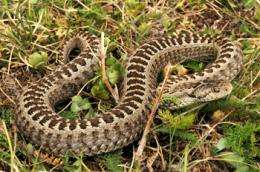Orsini's viper: Growth or reproduction?

Orsini's viper, a rare and protected species at risk of extinction in France, has an original reproductive strategy. In alternate years, it switches between reproductive and non-reproductive behavior. This strategy has recently been uncovered by a team from the Laboratoire Ecologie et Evolution (CNRS/UPMC/ENS), the Centre de Recherche en Ecologie Expérimentale et Predictive (CNRS/ENS), and the Université Paris Sorbonne. Based on a detailed analysis of field data collected over thirty years (on Mont Ventoux) and on mathematical modeling, the researchers demonstrated the advantages of this life history strategy. Far from being a constraint on the species, it allows Orsini's viper to make a better quality investment in reproduction, with no physiological cost or risk to parental survival. These results were published online in the journal Functional Ecology on November 23.
Orsini's viper is a small insectivorous snake that is rare and extremely threatened in France. Since the early 1980s, a population of Orsini's vipers on Mont Ventoux has been the subject of an in-depth monitoring study. In total, 160 females were monitored throughout their lives, revealing that adult specimens (which can live for more than 12 years) regularly alternate between reproductive and non-reproductive years. A mathematical model confirmed that natural selection could induce alternation between reproductive years and years of growth.
In this species, adult females reproduce every two years. In the non-reproductive years, snakes build up fat reserves and invest resources in body growth, which is possible throughout their lives and influences their fertility. The larger a female becomes, the more offspring she can produce. In a reproductive year, growth stops and all the acquired resources are committed to reproduction. This means that the reproductive success rate is high and that the immediate physiological impact on the mothers is low. This "strategy" differs radically from the behavior of other viviparous snake species, in which the females appear very thin after they have given birth. Their fat reserves 'melt away", which can threaten their survival. The strategy of Orsini's viper, however, allows a high quality litter to be born without such a "cost" to the parent.
Monitoring females before and after reproduction to assess their condition, body growth and survival rate has shed light on the logic behind this particular reproductive behavior, which is not - as generally thought - correlated with environmental fluctuations. The findings of this research could explain many other cases of intermittent reproduction in other species of both animals and plants. They also illustrate the value of long-term individual studies on natural populations for improving knowledge of the ecological and physiological mechanisms that determine species demography.
More information: Baron, J.-P., Le Galliard, J.-F., Ferrière, R. and T. Tully. 2012. Intermittent breeding and the dynamics of resource allocation to growth, reproduction and survival. Functional Ecology. doi: 10.1111/1365-2435.12023
Journal information: Functional Ecology
Provided by CNRS
















